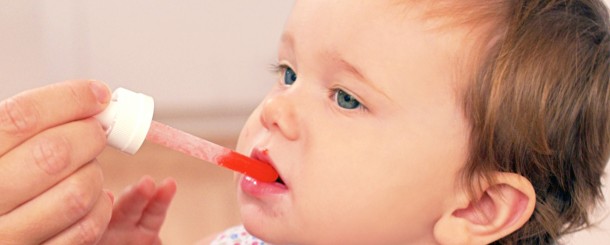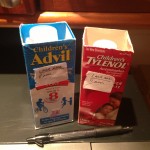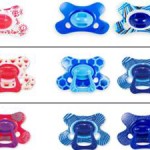If there’s one thing most little ones don’t like, it’s having to take medicine.
My daughter, at least, isn’t a fan of getting a squirt or two of Children’s Advil or Tylenol, even if it’s cherry flavored, in her mouth. We typically try to give the medicine to her while she’s in her high chair, and she’ll turn away, say “no, no, no,” grimace, and try to push the medicine away with her hands.
Then, my husband and I will hold our daughter’s head still and force her to take the medicine by squirting it into her mouth, or we’ll pretend to give her a pacifier (she’s a pacifier addict) and then squirt the medicine in her mouth instead (not a nice surprise for her, I’m sure).
Next time my daughter needs medicine, however, I’m hoping it’s going to be easier thanks to the four neat tricks for helping the medicine go down that make up today’s hint. And no, giving the medicine with a spoonful of sugar isn’t one of the tactics.
1. Think straitjacket. I learned this trick from Nurse Judy, the always helpful nurse at my pediatrician’s office. The trick: Wrap your little ones in a blanket (i.e. “think straitjacket,” she says), hold them at a 45 degree angle and squirt the medicine into the side of their cheek, making it clear “you mean business.” To be sure, this strategy certainly won’t work for all kids, and also probably works better if you start it sooner rather than later, so you’re little one hasn’t built up a negative association with medicine droppers and syringes.
2. Good old-fashioned bribery. If you find that the “straitjacket” approach doesn’t work well for your family, the good news is that there are other strategies you can try as well. Nurse Judy also suggests a bribery technique involving coins as well as letting your little one lick a lollipop (or you could try a popsicle) after each medicine squirt.
3. Change the delivery method. The site What to Expect offers a bunch of tips, including trying a different delivery method (think spoon or little cup). Another delivery method you could try: a pacifier. Here’s a really clever trick I came across at Buzzfeed and at PopSugar Moms related to pacifier medicine dispensing: Cut a hole in the tip of a pacifier and stick a medicine dropper through it, administering the medicine that way.
In addition, products exist that can help make giving medicine easier, such as the Sippy Sure “Medicine Dispensing Sippy Cup” and the Safety 1st Pacifier Medicine Dispenser, a pacifier through which you can dispense medicine.
4. Empower your little one. Finally, you could try letting your little one take charge, as feeling empowered may help make the medicine go down a little easier. We’ve done this lately, giving our daughter a medicine dropper to play with, and she uses it to dispense “medicine” to her dolls. My hope is that this doctor play will help her feel more comfortable taking medicine herself the next time around.
Meanwhile, for a short-lived time span of one or two days earlier this year, my friends say this similar technique worked for them: letting their 1-year-old daughter suck up the medicine from the syringe herself. Since then, however, “she hasn’t been able to coordinate pushing the syringe or being able to suck hard enough,” my friend says, adding “Maybe it was just luck?”
I tried their technique, and my daughter didn’t take it to it (I remember a dropper ending up on the floor), but trying the blanket technique is next up on my list.
What are your favorite tricks for helping the medicine go down?
Follow Hint Mama on Facebook and Twitter, and read more about her and her disclosures.








We’ve been dealing with this a lot with tylenol for teething! I strip him to a diaper, throw a towel on the changing table, sit up him, hold his arms down and go…haha…I’d say some of it gets in his mouth! These are great tips, thanks!
Thanks for covering this. Any tips on getting eye medicine into a squirmy toddler? Both goop and drops are insanely hard, and feeling like 90% of the meds end up on a cheek (floor, parent, hands) doesn’t really instill confidence in us that it will do its job.